If you haven’t already read Allahpundit’s piece on the Wisconsin Supreme Court race, please do so. The news is even worse than it appears because the conservative candidate ran what had been, for a long time, the successful playbook in Wisconsin politics.
Competitive Supreme Court races in Wisconsin, almost invariably for a vacant seat, typically follow a set pattern. Both candidates in the general election portray themselves as law-and-order candidates, with even the more-liberal candidate eschewing specific stances on political policy, especially if it could come before the Court. As neither candidate raises a lot of money, outside, in-state, groups are their proxies on TV and radio, with liberal groups typically delving into political policy and conservative groups typically exposing the liberal candidate as anything but law-and-order.
Milwaukee County District Judge, and former prosecutor, Rebecca Dallet began following most of this playbook in a 3-person primary with Sauk County District Judge Michael Screnock and Madison lawyer Tim Burns, portraying herself as the “centrist” between the two “extremists”. Meanwhile, Burns ran as a “big-D and small-d” Democrat, proudly proclaiming he would overturn every Scott Walker, Republican Legislature, and current Supreme Court action if he made the bench, and belittling the Federalist Society at a debate the Socitety hosted.
The reason I said “mostly” is the first commercial Dallet aired, during the primary, was an anti-Trump commercial. Incidentally, that is the only time, at least outside of the Madison media market, that Trump was any sort of focus in this race. This mostly-traditional playbook was good enough to get Dallet nearly 36% of the vote in the primary, which was far short of the over-46% Screnock received.
That’s when the script flipped. Typically, once one establishes oneself as a “moderate”, one does not veer off to one partisan side or the other in the middle of a campaign. However, the moment Dallet made it past the primary, she began to explicitly run against Walker, the Legislature, and everything they have done the last 7 years, her own politicized message amplified by both in-state and out-of-state groups.
Meanwhile, Screnock, without a lot of money of his own and the usual right-of-center groups taking a pass, stuck to the traditional low-money conservative judicial candidate playbook, saying little more than he would uphold the rule of law and use that to guide him in any decisions he would participate in. Eventually, Wisconsin Manufacturers and Commerce, typically the most-active of the right-of-center groups, did put out an ad exposing several rather questionable sentencing decisions by Dallet in child abuse cases.
The result was a surprising pasting of the conservative. How bad was it? A few points of data:
- Veteran political reporter Craig Gilbert saw something he never remembered seeing:
i can’t recall a contested/competitive statewide election of any kind in WI where the liberal or Dem candidate got 80% of the Dane County vote, as Dallet is on track to get in WI Sup Court race. Is there one? Herb Kohl didn’t even hit 80% in Dane in blow-out ’06 Senate victory
— Craig Gilbert (@WisVoter) April 4, 2018
Indeed, the last time a liberal or Democrat got 80% of the Dane County vote in a competitive statewide election was 1982, when Tony Earl got over 80% in the gubernatorial race. - J. Miles Coleman of Decision Desk HQ ran the results by Congressional District:
In the #WIsupremecourt election, Dallet & Screnock each won 4 Cong. districts. Dallet flipped #WI03 (west) & #WI08 (Green Bay) from Trump (outlined in gold). Dallet barely missed the rural #WI07, losing it by about 200 votes. Paul Ryan’s #WI01 went to Screnock by 5%. pic.twitter.com/casTAPnX8Y
— Decision Desk HQ (@DecisionDeskHQ) April 4, 2018
I will point out that only the 2nd, 3rd, and 4th Districts are currently held by Democrats. In a bit of good news, Coleman also noted that in 2015, which was a non-competitive 16-percentage point win for Justice Ann Walsh Bradley, her opponent carried Paul Ryan’s district by the same 5 points Screnock did. - While only two counties saw Screnock gain at least 350 more votes over his primary total than Dallet did over her and Burns’ combined primary totals (Waukesha at 3,375 and Washington at 2,256, the larger 2/3rds of what is known as the “WOW” counties that is the GOP base), Dallet had 25 counties where she gained at least 350 more votes over her/Burns’ primary totals than Screnock did over his primary total. In 12 of those counties, she gained at least 1,000 more votes than did Screnock. In 3 counties, Dane (32,027), Milwaukee (20,282) and Brown (3,747, also one of the example counties in Ed Morrissey’s book, Going Red), Dallet’s relative gain over her/Burns’ primary totals was greater than Screnock’s relative gain in his best county.
- WisPolitics reported that a two-term mayor who had won a surprise victory for the Assembly in 2016 as a Republican lost his bid for re-election handily.
If there is any good news, it is that, even though the turnout of 22% was a bit higher than other recent Supreme Court races, and the 32% turnout in Dane County was nearly the national turnout in November 2014, 1 million is but a fraction of the 2.4 million who turned out in Wisconsin that election.







Join the conversation as a VIP Member